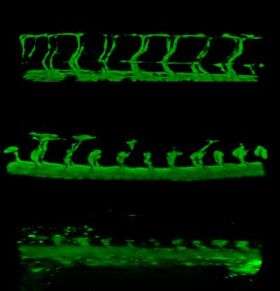Researchers identify novel anticancer drug from the sea

A collaborative team of researchers spearheaded by Dennis Carson M.D., professor of medicine and director of the Rebecca and John Moores UCSD Cancer Center at the University of California, San Diego (UCSD) has identified a potent new anti-cancer drug isolated from a toxic blue-green algae found in the South Pacific. The properties of somocystinamide A (ScA) are described in a paper that will be published online in Proceedings of the National Academy of Science the week of February 11 -15.
“We are excited because we have discovered a structurally unique and highly potent cancer-fighting compound,” said Dwayne G. Stupack, associate professor of pathology at the Moores UCSD Cancer Center. “We envision it will be perfect for emerging technology, particularly nanotechnology, which is being developed to target cancerous tumors without toxic side effects.”
The ScA compound was found in the cyanobacteria L. Majuscula, also known as “mermaid’s hair,” gathered off the coast of Fiji in the South Pacific by the laboratory of William Gerwick at Scripps Institution of Oceanography. A diverse team of researchers from UCSD’s Cancer Center, School of Medicine, Skaggs School of Pharmacy and Pharmaceutical Sciences, and Scripps worked to identify, screen and test marine compounds in vitro and in vivo. They found that ScA inhibits neovascularization, the formation of blood vessels that feed tumors, and also had a direct impact on tumor cell proliferation.
“The compound isn’t toxic to the cyanobacteria itself, but activates a ‘death pathway’, present in our cells,” said Stupack. “When the cells of the blood vessels that feed tumors become activated and proliferate, they become especially sensitive to this agent.”
Gerwick noted that if a normal-sized swimming pool full of cancer cells were treated with ScA, it would take only three milligrams – about the weight of a grain of rice – to kill all of the cancer cells.
Wolf Wrasidlo, Ph.D., senior project scientist at the Moores UCSD Cancer Center and first author of the work, added that the unique structure of this compound lends itself very well to nanotechnology, because it “incorporates spontaneously” into molecule-sized nanoparticles, important for the kind of highly targeted, combination therapy being developed to treat cancer. The structure is also simple enough that the scientists can reproduce it.
“ScA is the first, and most potent compound we’ve identified so far,” Stupack said, adding that it won’t be the last, as the Scripps team has identified more than 250 unique compounds from L. Majuscula alone. “But we don’t yet know how abundant ScA is, or if it’s feasible to harvest, so it is important that we have been able to produce this natural product in the lab.”
Source: University of California - San Diego



















